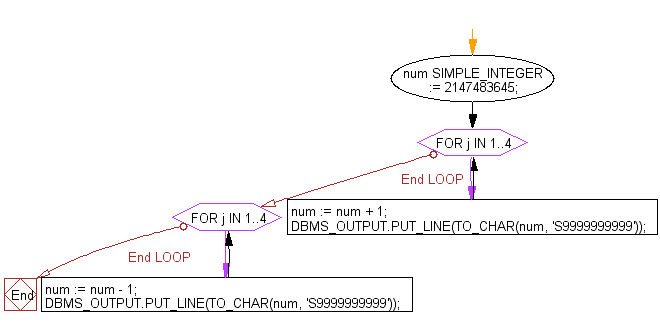PL/SQL DataType: Program to show the uses of SIMPLE_INTEGER datatype
PL/SQL DataType: Exercise-6 with Solution
Write a PL/SQL program to show the uses of SIMPLE_INTEGER datatype.
Sample Solution:
PL/SQL Code:
DECLARE
num SIMPLE_INTEGER := 2147483645;
BEGIN
FOR j IN 1..4 LOOP
num := num + 1;
DBMS_OUTPUT.PUT_LINE(TO_CHAR(num, 'S9999999999'));
END LOOP;
FOR j IN 1..4 LOOP
num := num - 1;
DBMS_OUTPUT.PUT_LINE(TO_CHAR(num, 'S9999999999'));
END LOOP;
END;
/
Flowchart:

Sample Output:
+2147483646 +2147483647 -2147483648 -2147483647 -2147483648 +2147483647 +2147483646 +2147483645 PL/SQL procedure successfully completed.
In the above example the initial value is 2147483645, when this value reach in upper limit it started from starting value.
Go to:
PREV : Write a PL/SQL program to show the upper limit of PLS_INTEGER.
NEXT : Write a PL/SQL program to show the uses of an unconstrained subtype, i.e., the same set of values as its base type.
Improve this sample solution and post your code through Disqus
What is the difficulty level of this exercise?
